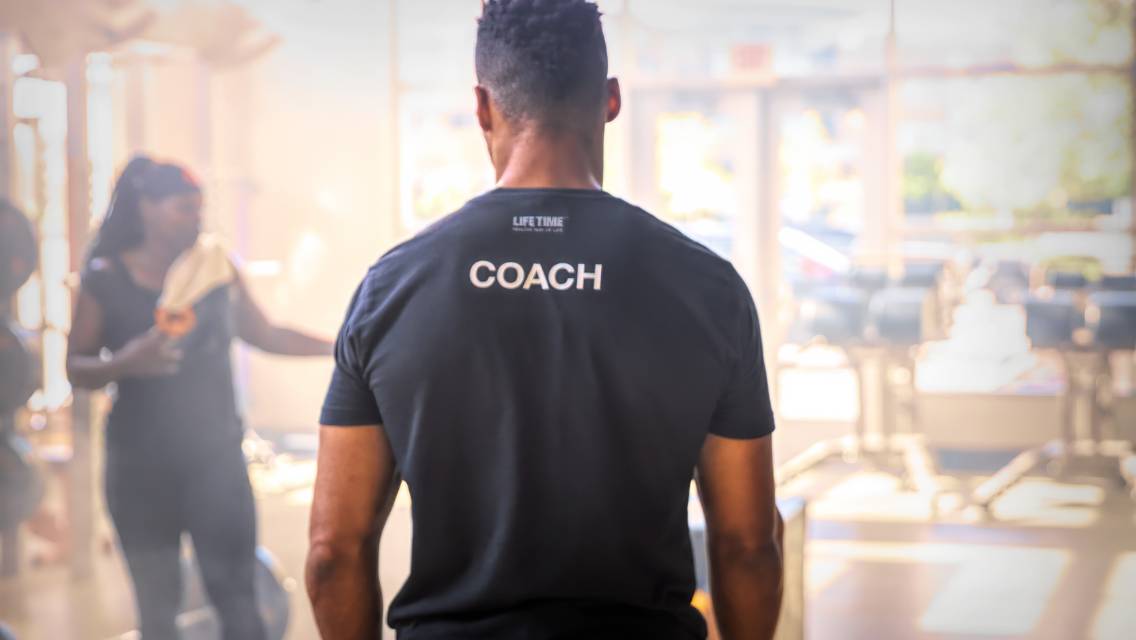The decision to hire a personal trainer is an empowering one. Putting a dedicated fitness expert in your corner can net you invaluable expertise and support for devising a smart workout strategy, overcoming emotional and physical roadblocks, and getting the real results you’re after.
According to an American College of Sports Medicine survey, personal training is a top trend for 2011, ranking above core training classes and boot camps in popularity. So, clearly, a lot of people are figuring out that it’s well worth the investment. Establishing an optimal training relationship, though, isn’t as simple as strolling into your health club and booking a session with the first PT who has an open spot in his or her schedule.
First, the two of you are going to be spending a lot of time together, so it’s worth putting in some legwork upfront to make sure you find someone with the right skills and chemistry. Second, you need to make sure you’re ready to do your share of the work required to get what you want out of the bargain.
“Whether you’re new to exercise or you’ve been working out on your own for a long time, using a personal trainer can give you that extra nudge,” says Tom Manella, senior director of personal training at Life Time Fitness in Chanhassen, Minn. “But you’ve got to show up for the experience, body and soul, and be really clear about creating a two-way exchange that works for you.”
Making It Work
After two years of regularly going to a health club, Michelle Nielsen, 36, of Phoenix, wasn’t seeing the results she had hoped for. She admits she felt overwhelmed by all the choices. “I would walk in and see a hundred machines and have no idea where to start. I’d flounder and wander, and eventually I got really frustrated and stopped going,” she says.
Nielsen realized that what she needed was direction and affirmation. “I wanted someone more knowledgeable than me to tell me what I should be doing, and that I was doing a good job,” she says.
Because Nielsen’s husband had been successful working with a personal trainer, she decided to sign up for training sessions, too. Having never invested that much time or money in herself, Nielsen didn’t know what to expect — from her trainer, or from the whole experience.
“Before the introductory session, I was really nervous. I sat in my car for a really long time before going inside,” she says. But once she met with the trainer, discussed her history and her goals with him, and began her plan, her anxiety evaporated.
“My trainer, Ryan Clark, was a great match for me,” she says. Nielsen was delighted to find that Clark was down to earth and respectful of her need for an unintimidating environment. He helped her outline specific goals and guided her toward them without pushing too hard. “It was a very personal journey for me from the get-go, and Ryan recognized that,” she says. “He was proud of me for being there. He knew that for me, showing up was a battle in and of itself.”
Over the course of two months of training with Clark three times a week, Nielsen experienced dramatic results. “My fitness improved leaps and bounds, and my body shape changed — but more importantly, I noticed a huge change in how I feel about myself.”
For Nielsen, hiring Clark proved to be time and money well spent — a happy meeting of minds, personalities, priorities and expectations. Looking to create that same sort of synergy with a trainer who’s dedicated to helping you achieve your own goals? Read on to discover four essential keys to success — gathered from experienced trainers and satisfied clients alike.
1. Find the Right Match
“Shopping around and meeting potential trainers is an important first step,” says Manella. Searching online can be overwhelming, so ask your local club for recommendations based on your objectives and fitness experience, talk with friends or family members who have used trainers, and speak with trainers on the gym floor, he suggests.
“Begin by asking about their credentials,” advises Kelli Calabrese, MS, CSCS, master trainer for Adventure Boot Camp in Orange County, Calif. Certifications, she says, are one way to ensure that trainers have the education required to competently design safe and effective exercise programs. So be sure to ask how long they’ve been training and whom they’re certified through. Because there are a number of organizations that certify trainers, focus on someone with national certifications (such as those from the American Council on Exercise, the National Strength and Conditioning Association, the National Exercise & Sports Trainers Association, or the American College of Sports Medicine) or a trainer with a degree in exercise science.
And make sure those certifications are current. “An expired certification is not a good sign,” says Manella. Another bad sign: trainers who work in run-down facilities. “Top-line gyms often have the best trainers,” says Philip Goglia, PhD, a Santa Monica–based personal trainer, registered nutritionist and author of Turn Up the Heat: Unlock the Fat-Burning Power of Your Metabolism. If the place gives you the creeps, chances are good that the trainer isn’t a winner either, he says.
Once you meet with the trainer or speak on the phone, you can better gauge his or her experience, the experts say. “You’ll want to know what types of training they specialize in and whether that fits with your situation and goals,” Calabrese says. A trainer with a basic certification will likely not be able to help you train for a figure competition or a triathlon, though. “There are specialty coaches out there who can help you tap into getting an edge on an individual sport,” she adds.
To help determine if a prospective trainer is right for you, Manella suggests asking him or her these questions:
1) What’s your experience working with people like me? (Specify your goals: losing weight, training for an event, coming back after an injury, building strength, etc.)
2) What results have you achieved with your clients? Over what time span?
3) Can I talk with some of your clients? (A good trainer should have no trouble providing references.)
4) How would you describe your style? (Some trainers are gentle and encouraging, while others are more aggressive; some direct, others collaborate.)
5) How much do you charge? (Rates vary a lot based on the trainer and location — anywhere from $30 to $300 per hour — but average from $50 to $100.)
6) Do you offer small-group sessions or other services, such as online training?
If possible, observe the trainer working with another client, suggests Jamie Atlas, founder of Bonza Bodies fitness studio in Denver. “It takes about five minutes of watching to know if the trainer is more into the client or themselves. Habits like chatting too much, being easily distracted and generally having low energy are warning signs of what might be to come,” says Atlas.
Beyond that, personal dynamics are key, says Manella. In other words, it helps if you genuinely like the trainer. “That doesn’t mean you have to be mirror images of each other, but common ground is important,” adds Goglia. “If you have one person who’s cracking sarcastic jokes and someone else who’s very serious, that could be a bad match. You want to be in tune.”
2. Focus on Clear Goals
Prior to your first active training session, discuss your objectives with your trainer so that he or she can come up with an appropriate plan to achieve them.
That process may involve some assessment drills: “You want to have an initial measure of things like posture, balance, flexibility and strength,” Goglia says. “It’s critical to record and retest to understand if you’re getting anywhere.” Depending on the trainer and your goals, you might also measure body-fat percentage, cardio fitness and body weight.
If you’re out of shape or haven’t worked out recently, your trainer may recommend an initial period of training designed to help you build a fitness base and avoid injury. That’s a good thing, because it will make all your subsequent workouts more effective. But right from the beginning, you should see the connection between the plan your trainer has laid out and the goals you want to achieve.
“It’s important to tweak that plan every few weeks as you improve,” says Alwyn Cosgrove, a Newhall, Calif.–based personal trainer and coauthor of The New Rules of Lifting book series. “But everything you do should be moving you toward your goal — whether that’s improving your cardio output, increasing your strength, losing weight or all of the above.”
If there are days you’re working out alone, you’ll need the trainer to map out the specific exercises you should complete, along with sets and reps. “Your trainer should provide you with routines that have a balance of both upper body and lower body, and also focus on the weaknesses you’re trying to improve,” says Goglia. “But you shouldn’t be doing the same exercises every single session.”
3. Develop a Strong Working Relationship
During the first few sessions, pay attention to how well you and your trainer sync up. Do you understand what she’s telling you to do? How well do you communicate with one another? Is she clued in to your body language to know when you need to be pushed harder and when you’ve had enough? Do you feel motivated or punished by her feedback?
As with any good relationship, you should feel like the trainer brings out the best in you. How he or she goes about reaching that objective may vary. “People have very different learning styles and motivational preferences,” says Manella. “Some clients want to understand the science behind every movement. Others just want someone to demonstrate how it’s done.” Some clients appreciate a little tough love, he notes — the kind you might get from a boot-camp-style trainer. Others want a gentler, more understanding approach.
The important thing, most experts agree, is voicing those preferences to your trainer so that he or she can respond. “Ask yourself, ‘Am I better with this person than I am alone?’” advises Manella.
A good trainer will also be open to answering any questions or concerns you bring to each session. If something isn’t working for you, or you hit a plateau, the trainer should be adaptable and work with you to adjust the routine.
No matter what the trainer’s style, he or she should strive to find ways to make exercise as natural and habitual for you as eating and drinking, says Shannon Wallace Jr., CPT, founder of 368 Athletics in Frederick, Md.
“I tell our trainers their primary job is education,” says Manella. “A good trainer should give you everything you need to know to make fitness a permanent part of your lifestyle.”
Of course, whether or not you comply with that encouragement is up to you. “If you’re only seeing me once a week, then you’ll need to weight train at least twice a week outside of our sessions to see the results you want,” says Eric Wilson, MS, a Seattle-based exercise physiologist and creator of the Comprehensive Lifestyle Plan, a personal-training philosophy that focuses on the whole person. Wilson suggests you duplicate the training experience at home as best you can: Put on music that gets you going, he suggests. Warm up. Give yourself a pep talk. “You need to be able to get in the zone even though it’s just you,” he says.
Happily, the more you get to know your trainer, the more you’ll automatically hear his or her voice directing you through the moves. After a while, you’ll begin to internalize that advice, and it will become second nature.
4. Know When to Move On
Eventually, all training relationships come to an end — ideally, for the happiest of reasons: The client has achieved his or her initial goals, has successfully integrated exercise into his or her lifestyle, and no longer feels the need for a trainer.
Perhaps there’s another chapter in store — refresher sessions, next-phase objectives, sports-specific training — or perhaps not. It’s entirely up to you. Let your budget, priorities and training appetite be your guide.
For Michelle Nielsen, the conclusion of her training sessions felt like a graduation of sorts. “Ryan and I both sensed my confidence and skills had reached a point that I might be able to join his small-group class.” That way, says Nielsen, she still benefited from his direction and expertise, but the classes were more affordable than private sessions.
For some clients, a limited package of training sessions is all they want or can afford at the moment. Other clients are in it for the long haul: “They have the means to pay for a trainer indefinitely, and they like the ongoing accountability and motivation the trainer provides,” says Manella.
As long as the cost-benefit analysis is working in your favor, the decision to keep training is easy. But what do you do when the relationship just isn’t working, or when the investment isn’t paying off the way you’d hoped?
Many clients rightfully walk away when they lose confidence in the trainer’s commitment to their results, says Jamie Atlas. “Clients sense when a trainer has stopped caring and started taking them for granted,” he says.
“If you’re unhappy with your results, or with the experience, you need to sit down and talk to your trainer,” Goglia says. “But, be honest with yourself about whether or not you’re doing the work.” (See the “10 Tips for Making the Most of Your Training Sessions” below.)
Also pay attention to how you feel before, during and after your training sessions. A bit of preworkout apprehension is natural, but if you find yourself dreading each appointment, that could be a red flag. During the workout, you should feel challenged, but not pushed beyond your limits. Afterward, check in with yourself: Are you happy you went? Did you try something new and succeed? Do you feel empowered, or beat up?
An off day here and there is normal, but if you see a pattern of decline or negativity, it could be a clue that you need a change. “If you talk to the trainer and he’s not being responsive or adjusting, it’s time to move on,” Wallace says.
Scott Jackson, CPT, CSCS, founder of Real Life Fitness facility in Nevada City, Calif., recommends an honest approach: “They’re in business, and they need to know how to improve. If the problem was their personality or their commitment, letting them know in a gentle way could help them in the future.” Then, he suggests, find another trainer — “ASAP, while your motivation is still strong.”
10 Tips for Making the Most of Your Training Sessions
If you’re spending valuable time and money on personal training, you deserve to get great results. And a lot of that depends on you. We asked some top-shelf PTs what they wish more of their clients would do in the name of great fitness outcomes, and here’s what they said:
- Ditch the chitchat. Although a little back and forth builds rapport and keeps things lively, a constant stream of small talk can be detrimental — particularly when you’re both distracted from your efforts, timing and form.
- Show up on time. Every minute you’re late chips away at the time you scheduled for fitness and can totally throw off your trainer’s workout plan. Many trainers like clients to arrive early for a proper warm-up before their session starts.
- Respect the stopwatch. There’s a reason your trainer is specifying 30- or 60-second breaks between sets and asking you to hold the intensity of cardio intervals for specific durations. Adhere to that timing, and you’ll see far better results.
- Clean up your eating. No amount of working out can hide the evidence of a lackluster diet. Follow your trainer’s nutritional advice, make the switch to more whole, natural foods, and you’ll be amazed at the difference it makes.
- Don’t fib. Your trainer will have a hard time managing your program and results if you claim to be exercising more or eating better than you really are. Be candid about what you’re willing to do — then let your trainer be frank about the results you can expect.
- Be a “yes” person. Many trainers have an aversion to the phrase “I can’t do that.” Have an injury? Say “I have an injury” — and let your trainer adjust accordingly. But be open to trying new things, even if they don’t come easily at first.
- Trust your trainer. It’s OK to ask questions about why you’re doing certain exercises, but in the end, you either trust your trainer’s expertise or you don’t. Interrupting and arguing can waste time and undermine the dynamic of your relationship, causing frustration for you both.
- Get good Z’s. Your fitness recovery and progress hinge on adequate sleep. And so does your available energy for workouts. Showing up exhausted drastically limits the potential of your sessions.
- Speak your truth. Personal trainers can be intuitive, but they’re not mind readers. Tell them how your body feels, and how your motivation is faring, so they can tweak your regimen based on your feedback.
- Put your heart into it. If you really want to get healthier and more fit, bring that attitude to your training sessions — and to your willingness to change your life. Enthusiasm breeds success.





This Post Has 0 Comments